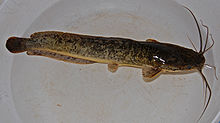- Clarias gariepinus
-
Clarias gariepinus 
Scientific classification Kingdom: Animalia Phylum: Chordata Class: Actinopterygii Order: Siluriformes Family: Clariidae Genus: Clarias Species: C. gariepinus Binomial name Clarias gariepinus
(Burchell, 1822)Clarias gariepinus or African sharptooth catfish is a species of catfish of the family Clariidae, the airbreathing catfishes.
Contents
Natural Distribution
They are found throughout Africa and the Middle East and live in freshwater lakes, rivers, swamps, as well as human-made habitats, such as oxidation ponds or even urban sewage systems.
The African sharptooth catfish has been moved all over the world in the early 80s for rearing purposes and is therefore found in countries far outside its natural habitat like Brazil, Vietnam and India.
Description
The African sharptooth catfish is a large, eel-like fish, usually of dark gray or black coloration on the back, fading to a white belly. In Africa, this catfish is second in size only to the Vundu of the Zambesian waters.[1] Clarias gariepinus has an average adult length of 1-1.5 meters. These fish have slender bodies, a flat bony head, notably flatter than in the genus Siluris, and a broad, terminal mouth with four pairs of barbels. They also have a large, accessory breathing organ composed of modified gill arches. Also, only the pectoral fins have spines. They can weigh up to 29 kg.[2]
Habits
It is a nocturnal fish like many catfish. It feeds on living as well as dead animal matter. Because of its wide mouth, it is able to swallow relatively large prey whole. It has been known to take large waterbirds such as the Common Moorhen.[3] It is also able to crawl on dry ground to escape drying pools. Furthermore, it is able to survive in shallow mud for long periods of time, between rainy seasons.
African catfish sometimes produce loud croaking sounds, not unlike the voice of the crow.
Natural spawning
Spawning mostly takes place at night in the shallow inundated areas of the rivers lakes and streams. Courtship is preceded by highly aggressive encounters between males. Courtship and mating takes place in shallow waters between isolated pairs of males and females. The male lies in a U-shape curved around the head of the female is held for several seconds. A batch of milt and eggs is released followed by a vigorous swish of the female's tail to distribute the eggs over a wide area. The pair usually rest after mating (from seconds up to several minutes) and then resume mating.
There is no parental care for ensuring the survival of the catfish offspring except by the careful choice of a suitable site. Development of eggs and larvae is rapid and the larvae are capable of swimming within 48–72 hours after fertilization.
Rearing of African catfish
The rearing of the African sharptooth catfish in Africa started in the early seventies in Central and Western Africa as it was realized that it was a very suitable species for aquaculture as:
It grows fast and feeds on a large variety of agriculture by-products. It is hardy and can tolerate adverse water quality conditions. It can be raised in high densities resulting in high net yields (6–16 t/ha/year). In most countries it fetch a higher price as tilapia's as it can be sold live at the market. It matures and is relatively easy to reproduce in captivity.
References
- ^ Ecotravel South Africa
- ^ Ecotravel South Africa
- ^ Anoop KR, Sundar KSG, Khan BA & Lal S (2009) Common Moorhen Gallinula chloropus in the diet of the African catfish Clarias gariepinus in Keoladeo Ghana National Park, India. Indian Birds 5(2):22-23
External links
- All Catfish Species Inventory
- Handbook on the rearing and artificial reproduction of the African catfish [1]
- The African catfish [2]
- Chari in the Bari, Homestead rearing of African catfish [3]
Categories:- Clarias
- Fish of Africa
- Animals described in 1822
Wikimedia Foundation. 2010.


